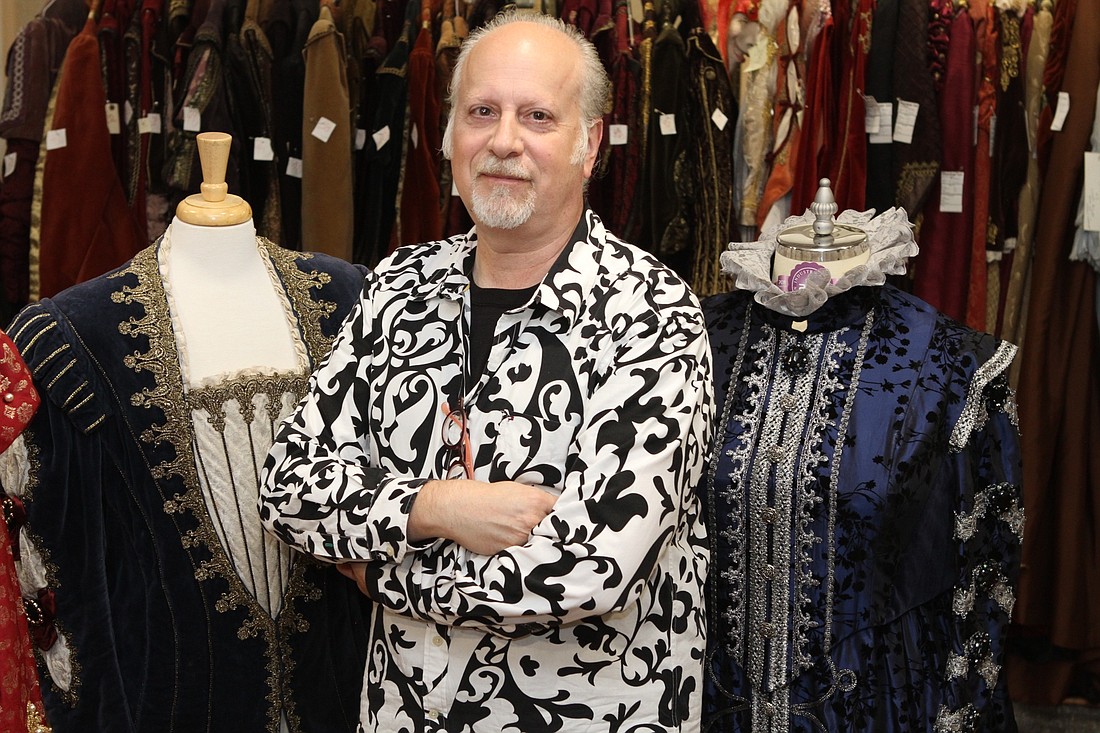- April 18, 2024
-
-
Loading

Loading

Intricately sewn and beaded costumes — imbued with a historic past — hang on the racks and mannequins at the Sarasota Opera, ready to dress the singers this season (and for decades to come).
“This is very exciting,” designer Howard Tsvi Kaplan says, sifting through the exquisite gowns and suits that make up the opera’s newly acquired $2 million costume collection. “We can do so much with these. So many possibilities. It’s just wonderful.”
This recently obtained wardrobe comes from the Toronto, Canada-based company Malabar Ltd. and is part of the opera’s nearly complete $40 million comprehensive campaign.
Securing the costume collection was a feat that will ultimately save the opera about $100,000 in annual costume costs, generate rental revenue and make the organization the leading costume provider to opera companies in North America.
“When we were up at Malabar moving the collection, it was so nice to discover new things that I had never seen there,” says Kaplan, who has been the Sarasota Opera’s resident costume designer for the past 22 seasons. “I looked through the clothes and thought: ‘This will be great for our youth opera. This will be great for this or that production.’”
The collection consists of costumes for more than 130 performances, including 30,000-plus individual pieces. The items have been worn by such legends as Luciano Pavarotti, Beverly Sills and Stephanie Sundine. Malabar has been a leading independent provider of costumes to opera companies in North America since the late 1950s, and Kaplan has always had close ties to its owner, Luigi Speca.
“We are so conscientious about wanting to preserve the collection; it’s as if we’re storing museum pieces,” Kaplan says. “We’re going to be using them, but we’re also going to be taking care of them.”
To house this inventory, the opera is building a new climate-controlled warehouse; it will consolidate the opera’s costumes as well as its props, sets and scenery. Presently, the opera stores much of its stock in a warehouse on Tallevast Road. (Overflow is in off-site trailers.) The opera has a contract on a site in the Manasota Industrial Park with plans to build a 50,000-square-foot space. The design and construction cost estimate is between $2 million and $3 million, which is not included in the current fundraising effort.
As for the overall $40 million fundraising campaign, which quietly began in 2014, $36.6 million has already been raised. The money is designed to position the opera for the future through an increase in annual giving and growth of its endowment.
More than $3 million has been raised to support capital projects, including the 2016-built Steinwachs Artist Residences. The opera’s endowment has doubled to $9 million, and an additional $17 million has been generated in annual support. Through the Ernie and Alisa Kretzmer Legacy Challenge, more than $10 million in legacy pledges have been made to the endowment.
To launch the final phase of the campaign and the costume project, longtime opera supporters Paul and Sharon Steinwachs have pledged a challenge grant of $500,000, contingent upon the opera raising its own $500,000 by Dec. 31. To date, $250,000 of that goal has been met.
“The endowment growth and the artist residences will have long-term positive effects for the company,” Executive Director Richard Russell says. “Now with the costume acquisition, we have contained costs for the future and created an avenue for future earned revenue, helping to create a stable funding base.”
Sarasota Opera, founded in 1960, is entering its 61st season (beginning Nov. 1 with “Rigoletto” and ending March 22 with “La Wally”), and it has garnered international attention with its Masterworks Revival Series and the Verdi Cycle. The opera also maintains a commitment to education through “Explorations in Opera” performances for local schools and the industry-leading Sarasota Youth Opera program.
Kaplan, who is based in New York, has designed costumes for more than 85 of the opera’s productions, including “The Barber of Seville,” “The Crucible” and “Of Mice and Men.”
He often heads to downtown Manhattan to shop when brainstorming new costume builds or seeking unique finds to bring back to Florida. When he is in Sarasota, he visits Boca Bargoons and other area fabric stores to support the local business community. The process of creating, storing and preserving the costumes is an absolute team effort.
“During season, there are about 14 people working there,” Kaplan says, alluding to the opera’s on-site costume workshop. “We make an average of approximately 400 costumes every season.”
These staff members help execute his expert vision, which has been honed over four decades.
Prior to his work with the opera, Kaplan spent 12 years as the principal designer for the Ringling Bros. and Barnum & Bailey Clown College. He has also designed for Opera San Antonio and was a resident designer for both Alley Theatre and Asolo Repertory Theatre.
“I’ve been doing this for almost 40 years,” Kaplan says. “I always wanted to do costumes and clothing, and it’s very rewarding. I love working with the Sarasota Opera, and this costume collection is just going to be wonderful for our productions.”